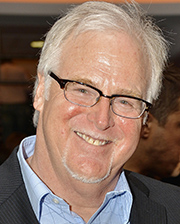
The most complex and challenging position in the foodservice industry today has to be in the marketing department. Technology and the Internet are disrupting their world with new marketing channels so rapidly that they are figuratively laying new tracks while 10 trains are running. How did it happen and what can they do to stay ahead of the curve? Let’s examine the five stages of foodservice marketing.
Marketing 1.0 (1918-1995): “It’s all about the ad.” Every November the media sales reps from the magazine, newspaper, radio or television station that the restaurant advertised with called the director of marketing (or owner if there is no marketing department) and asked what their advertising budget was for the upcoming year. Then they took you out for dinner, drinks, games, events or other varied and sundry forms of merrymaking. You get a jovial call from them the next day and they cajole you to spend a little more with them and less with the other guy. You do or you don’t, but either way, your marketing channels were finite and linear, all B2B (business to business). Your ads told the customer who you were, what you were selling, and how awesome you were. Diners took you at your word and the resulting traffic uptick was almost always in line with projections. Occasionally a curveball is thrown to the marketing team, like when limited-time offers gained traction across the industry in the 1990s. First it’s annually, then quarterly, then monthly. You hire a culinary team, plot out the year’s offerings and then chart the necessary sourcing, scheduling, point-of-sale and training. But you got used to it. For nearly eight decades, brand marketing was analog and relatively simple. But then, suddenly, simple got hard.
Marketing 2.0 (1996-2000): “It’s all about the website.” Sometime in 1996, your CEO read a Wall Street Journal story about these new dotcom companies and how the “interweb” might change business in general, and maybe even the foodservice industry in particular. He determines that, “We need a stronger Web presence.” A decision is made to create a company website, and the marketing team is tasked to run it and “go digital.” That new IT Department guy has a college roommate who builds websites, and you find an eager 22-year-old, seasonal intern to manage and maintain it. After all, he’s had his own AOL email address for nearly two years, he must know what he’s doing. Ethan Zuckerman, a digital designer for Tripod.com, creates the pop-up ad in the late ’90s, and suddenly the website’s potential transforms from informational to transactional. Now you have to figure out how to “monetize” your website, along with all the traditional advertising you’re still engaged in. The restaurant website of 1998 is chockablock full of copy, logos, coupons, promises and pop ups. Your magazine, newspaper, radio and TV media rep buddies view the Web as an unwelcome alien force siphoning off their entitled ad dollars and promising “eyeballs” and “impressions” instead of higher customer counts. None of them think of using their own websites for client advertising. There are dozens of new dotcom companies exhibiting at the 1999 NRA Show selling solutions to foodservice problems that don’t actually exist. Scores of “tech wizards” visit your marketing department monthly and offer lofty, giddy and contradictory consulting advice on how to maximize your web presence and digital channels. Confusion reigns and simplicity flees faster than a dishwasher on a 15-minute break. Welcome to the world of digital marketing.
Marketing 3.0 (2001-2008): “It’s all about the Web.” After the dotcom bubble bursts, tech firms wise up and begin focusing on what the Internet does best: reducing complexity and middle layers in both the organizational and supply chains. This adds transparency to the marketing process and begins to shift power from the brand to the diner, creating the necessity of B2C (business to customer) engagement. Marketing becomes more demanding than Gordon Ramsay at contract time. As cost layers erode and reams of customer data spew forth, something called “social media” suddenly emerges. Marketing departments industrywide hire 22-year-old seasonal interns to manage their Facebook and Twitter accounts because they’ve had their own MySpace account for like, two years. Just when you thought you had a handle on all these new marketing channels, deal-of-the-day emerges, and you go from Grey Poupon to pay Groupon. Despite the pressure, smart restaurant marketers recognize the benefit behind the change tsunami: direct marketing, more scale, greater efficiency, and a clearer picture of the customer than ever before. Now, what to do with all this data we’re generating?
What's next in marketing
Marketing 4.0 (2009-2015): “It’s all about the data.” The convergence of social media (think Facebook, Twitter, Vine, Instagram, Snapchat), location-based sites (Yelp, TripAdvisor, FourSquare, Groupon) and the smartphone has driven foodservice marketing into a realm of integrated complexity that would be considered science-fiction-like in any university business class just 20 years ago. Marketing influence has also shifted. Today customers believe what other customers say more than what the restaurant itself says. And the mindful customer is always the enemy of the thoughtless business. Factor in the rise of sharing economy companies nudging into foodservice delivery like Uber Eats and Postmates combined with the emerging intentions of Facebook Message and Google Pages to now become restaurant referral sites, and the marketer’s job description seems to be rewritten quarterly now. But focus is still our greatest ally: the competitive edge today will most certainly go to those foodservice companies who can turn all that data into insight into value. But no one foodservice company outside of Silicon Valley has proven exemplary at that. Yet.

How has your business adapted to rapid shifts in marketing? Join the conversation in the comments below.
Marketing 5.0 (2016-?): “It’s all about agility.” How can we know what the future holds if we base our decisions strictly on our knowledge of the past? We can’t, but we can surmise with certainty that more change is coming, as technology continues to disrupt foodservice marketing, training, hiring and systems. It’s an agility imperative for restaurant marketing teams in 2016. They must be hyper-alert and ultra-vigilant to shifting trends and new opportunities. Adjusting quickly and correctly, and then taking action immediately, are also must-have skills. Study what the best marketers in the tech sector are doing, because we’re all tech companies now. Marketing at the speed of change is a priority in 21st century foodservice. Because the restaurant business is not like an escalator: if you’re standing still, you’re walking backwards.
Jim Sullivan is a popular speaker at marketing and leadership conferences around the globe. Learn more at Sullivision.com, and follow Jim on Twitter and YouTube @Sullivision.





